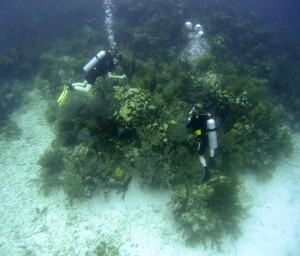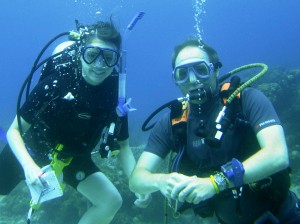A Griffith University researcher and her collaborators have found that choosing the right partner could mean the difference between survival and death for certain coral species.
The finding has significant implications for understanding thermal bleaching tolerances and coral’s potential for survival in a rapidly warming world.
Dr Emma Kennedy, of Griffith’s Australian Rivers Institute, undertook the “mammoth task” of studying more than 600 colonies of an endangered coral that is a keystone species in the Caribbean and fundamental to coral reef building. It was the biggest study done on a single coral species.
Institutions from around the world, including The University of Queensland and lead Exeter University in the United Kingdom collaborated in the paper ‘Symbiodiniumbiogeography tracks environmental and geographic patterns rather than host genetics in a key Caribbean reef-builder,Orbicella annularis’, published in the journal Proceedings of the Royal Society B.
 The authors found interesting biogeographic patterns in the species of symbionts they found associated with the coral.
The authors found interesting biogeographic patterns in the species of symbionts they found associated with the coral.
The researchers genetically typed colonies of the endangered boulder star coral species Orbicella annularis as well as all the symbionts that were found living inside its tissues.
“As well as being of high conservation and ecological importance, the coral is unusual as it can pair up with a number of different symbiotic algae species; different symbiont types can confer different properties (growth rates, bleaching tolerances) to the coral host,” says Dr Kennedy, who undertook the research during her PhD at Exeter.
“This means that even genetically identical (twin) corals will behave and respond differently to environmental stress if they happen to partner with different symbionts.”
For example, more northerly corals in the Bahamas almost always teamed up exclusively with a hardy and common generalist species called ‘SymbiodiniumB1’, while in easterly Barbados corals appeared to pair with more diverse mixes of more thermally-sensitive species.
“These relationships are particularly interesting to scientists, as the coral-symbiont pairing can affect bleaching outcomes for corals – literally choosing a different partner could mean the difference between survival and death when sea temperatures become too warm and start disrupting the coral-symbiont relationship,” Dr Kennedy says.
“This relationship breakdown occurs as part ofa phenomenacalled ‘coral bleaching’, where symbionts are lost/expelled from their coral host when they become heat-stressed, eventually causing the coral – which relies on the tiny photosynthetic algae for nutrition – to starve to death if they don’t return/recover to healthy levels in time.
“Sadly, coral bleaching is being seen more frequently around the world as a result of rising global sea temperatures: this summer we saw the third ever global coral bleaching event, which also happened to be the most severe coral bleaching on record.”
 The study found that the local reef environment tended to determine which symbiont species paired with the corals;boulder-starcorals living on reefs which have cooler summers had very different symbionts than those living on naturally warmer reefs.
The study found that the local reef environment tended to determine which symbiont species paired with the corals;boulder-starcorals living on reefs which have cooler summers had very different symbionts than those living on naturally warmer reefs.
The findings enabled the researchers to link, for the first time, some specific symbiont species to environmental conditions. For example “SymbiodiniumB1j” were often found in corals that lived on reefs with more nutrients in the water.
Dr Juan Ortiz, of The University of Queensland, said the study highlights how important it was to consider the holobiont — an entire community of living organisms that make up a healthy coral head – if researchers were to understand past and future responses of coral reefs to a rapidly changing environment.
“Reefs that look exactly the same when you dive on them may have completely different ecological properties as a consequence of the different types of algae that the same corals may host,” Dr Ortiz said.
